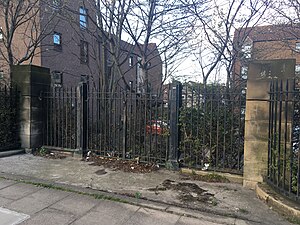|
Portobello Power Station
Portobello Power Station was a coal-fired power station in Portobello, Edinburgh which was built in 1923 by the Edinburgh Corporation in order to cope with the increasing demand for electricity in the city.[1] HistoryAlthough originally intended to be built in 1913, its construction was delayed because of the First World War, and it was formally opened by King George V 10 years later.[2][3] Its electricity was used to power Edinburgh and the surrounding region while waste heat warmed the water of Portobello Open Air Pool.[1] In 1938 the design of the station was extended by Edinburgh architect Ebenezer James MacRae; its six individual chimneys were replaced with a single 365 feet tall stack,[4] which weighed 10,000 tons, was made up of 710,000 bricks[5] and cost in the region of £118,000 to build.[1][6] Between 1952 and 1955, the power station achieved the highest thermal efficiency of any station in the UK, with peak output of around 279 megawatts,[7] although an explosion in February 1953 led to a two-hour power blackout across Edinburgh. The explosion, which could be heard a mile away, was caused by sea spray collecting on high-voltage insulators in the main-grid substation.[8] The power station closed on 31 March 1977[9] and demolished in 1980; a new housing estate was built on the site.[1] During demolition, the chimney had to be taken down brick by brick because of its proximity to nearby houses.[10] The Portobello coat-of-arms on the power station was rescued during demolition and it was planned to incorporate it into a new sports centre to be built in the area.[11] This never happened and in 2016 the broken coat of arms was located in a City of Edinburgh Council storage facility in the west of Edinburgh.[12] References
External linksWikimedia Commons has media related to Portobello Power Station. |
||||||||||||||||||||||||||||

